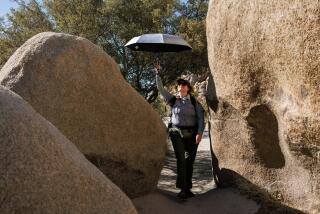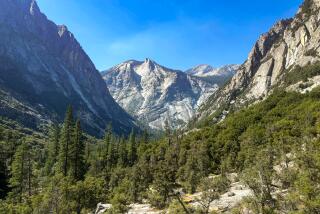A Balancing Act for Nation’s Parks
- Share via
YOSEMITE NATIONAL PARK — Standing upright, they reached 30 stories into the sky. For more than 1,000 years, the two giant sequoias thrived in the Mariposa Grove along Yosemite National Park’s southern border.
When they fell several weeks ago, a hole the size of a jetliner opened in the forest canopy.
It may be months before park biologists determine what did in the trees. It appears that one sequoia growing near a creek collapsed and toppled the other.
It’s possible that foot traffic around the base of the trees and erosion along the creek damaged their shallow roots. It’s also possible that a trail built more than 50 years ago diverted too much water toward the trees, loosening the soil.
“We just don’t know yet,” Park Ranger Deb Schweizer said.
Park officials have tried to protect the big trees, fencing off some of the larger sequoias. Long gone are the days when a truck-sized hole could be carved through a living sequoia, as in the grove’s Tunnel Tree, which collapsed in 1969.
But rangers know that even a hug leaves acid from human hands that can eat away at the bark.
“We just need to find a balance,” Schweizer said. “We may be loving them to death.”
Between 1855 and 1864, about 653 people visited the grove. Now, more than a million people each year walk among the world’s oldest and largest trees, which grow naturally only on the western slopes of California’s Sierra Nevada.
While more visitors mean additional tourist dollars, park managers here and elsewhere struggle to find a balance between protection and exploitation. Managers say that task has been tougher since the September 2001 attacks because resources have been diverted from wildland stewardship to homeland security.
In Yellowstone National Park, it’s the fight over snowmobile access to the backcountry. Great Smoky Mountains National Park, the nation’s most visited with 9 million tourists annually, sits in a haze of air pollution, in part because of all the vehicles on park roads. Managers at Virgin Islands National Park struggle to protect fragile coral reefs, while in Alaska’s Denali National Park and Preserve, some fear degradation from motorized access.
“It’s really a fine line,” said Michelle Jasperson, associate director of the National Parks Conservation Assn.’s Pacific regional office. “But what can we do, fence off every park? That’s just not logical.”
Last year, 277 million people visited the National Park Service’s 388 parks, monuments and historic sites. In 1960, there were just 80 million visits.
“You end up with a conflict between the philosophy of preserving things versus providing more recreation,” said David Barna, the park service’s top spokesman in Washington. “Our dream is that everyone in America can stand on this mountain and see this beautiful scenery, but our worst nightmare is that everyone decides to do it on the same day.”
The challenge for park managers, he says, is to learn from the past and understand the changing future.
Rangers used to feed bears in front of the tourists at Yellowstone, where the Old Faithful Inn, a National Historic Landmark with 327 guest rooms, was built near the great geyser in 1903.
“If we were doing it over, we wouldn’t do that,” Barna said. “We say we’ll preserve these places for future generations and provide for visitor use and access, but those two things conflict. Any time you want to build a parking lot in a park, you’re satisfying half the needs, but you’re also impairing the resources.”
In many parks, officials are taking steps to reverse the human impact.
The controversial $441-million Yosemite Valley Plan calls for, among other things, reducing parking spaces and improving a shuttle-bus system. Officials say it will ultimately result in a park with fewer facilities but a better visitor experience.
At Zion National Park in Utah, a plan put into place four seasons ago to reduce traffic by providing shuttle buses has led to the return of abundant wildlife in the upper canyon. An unusual sight recently was a mountain lion with three cubs in an area once busy with automobiles.
Beginning next winter in Yellowstone, snowmobile users will have to get reservations to enter the park, and most will have to be accompanied by commercial guides. The plan also sets daily limits, along with noise and emissions standards.
“It strikes a balance between phasing out all snowmobile use and unlimited use as we’ve had in the past,” said Cheryl Matthews, park spokeswoman.
In Great Smoky Mountains National Park, which suffers some of the worst pollution in the park system, managers are considering a plan to use shuttle buses in the popular Cades Cove area, where 2 million tourists a year drive the 11-mile scenic loop.
At Virgin Islands National Park and Coral Reef National Monument, where more than a million visitors a year explore the underwater ecosystem, boaters dropped anchor wherever they liked until a few years ago, often damaging the fragile reefs. The park has since spent several hundred thousand dollars -- raised by private foundations -- to install 215 moorings.
“Now we’re watching the sea grass beds come back,” Supt. John King said. “It’s helping reverse the trend of declining resources.”
Another stress on resources is the need for additional security measures to protect against potential terror attacks. Visitors are now screened at seven park sites, from the Washington Monument to New York’s Federal Hall, where George Washington was sworn into office. Eleven park sites are located along international borders, which must be monitored.
Responding to the increased security measures required under federal terror alerts costs the Park Service about $2 million a month, Barna says.
Back on the western slopes of the Sierra Nevada, Yosemite’s Schweizer stands at the base of one of the fallen giant sequoias and marvels at how their weaknesses, in fact, saved them from the ax more than a century ago.
When logging companies began to cut sequoias in the 1860s, they discovered that the wood was so fragile that the trees splintered as they fell. Sections were used for grape stakes, pencils, shingles and toothpicks, but loggers stopped cutting them by 1900.
“They’re pretty noble things, pretty impressive,” Schweizer said. “And there is just something about people that makes them want to connect with these trees.”
More to Read
Sign up for The Wild
We’ll help you find the best places to hike, bike and run, as well as the perfect silent spots for meditation and yoga.
You may occasionally receive promotional content from the Los Angeles Times.






